Project Management Report: TFL Bollo Lane Development & Analysis
VerifiedAdded on 2023/06/17
|12
|2102
|321
Report
AI Summary
This report provides a comprehensive analysis of the Transport for London (TFL) Bollo Lane development project, which aims to construct over 800 new homes in Acton and manage an anniversary event for the G&S society. The report covers various aspects of project management, including the selection and application of methodologies such as Waterfall and SCRUM, the development of a network diagram to visualize project timelines, and a stakeholder analysis to identify and prioritize key stakeholders like the Town Hall committee, government, investors, and employees. Additionally, a work breakdown structure (WBS) is outlined to break down the project into smaller, manageable tasks, and a risk analysis is conducted to identify potential risks such as power failures, weather changes, and resource shortages, along with mitigation strategies. The report concludes that effective project management, including planning, organizing, and risk analysis, is crucial for the successful completion of the project and enhancement of business activities.

Sample
Paraphrase This Document
Need a fresh take? Get an instant paraphrase of this document with our AI Paraphraser
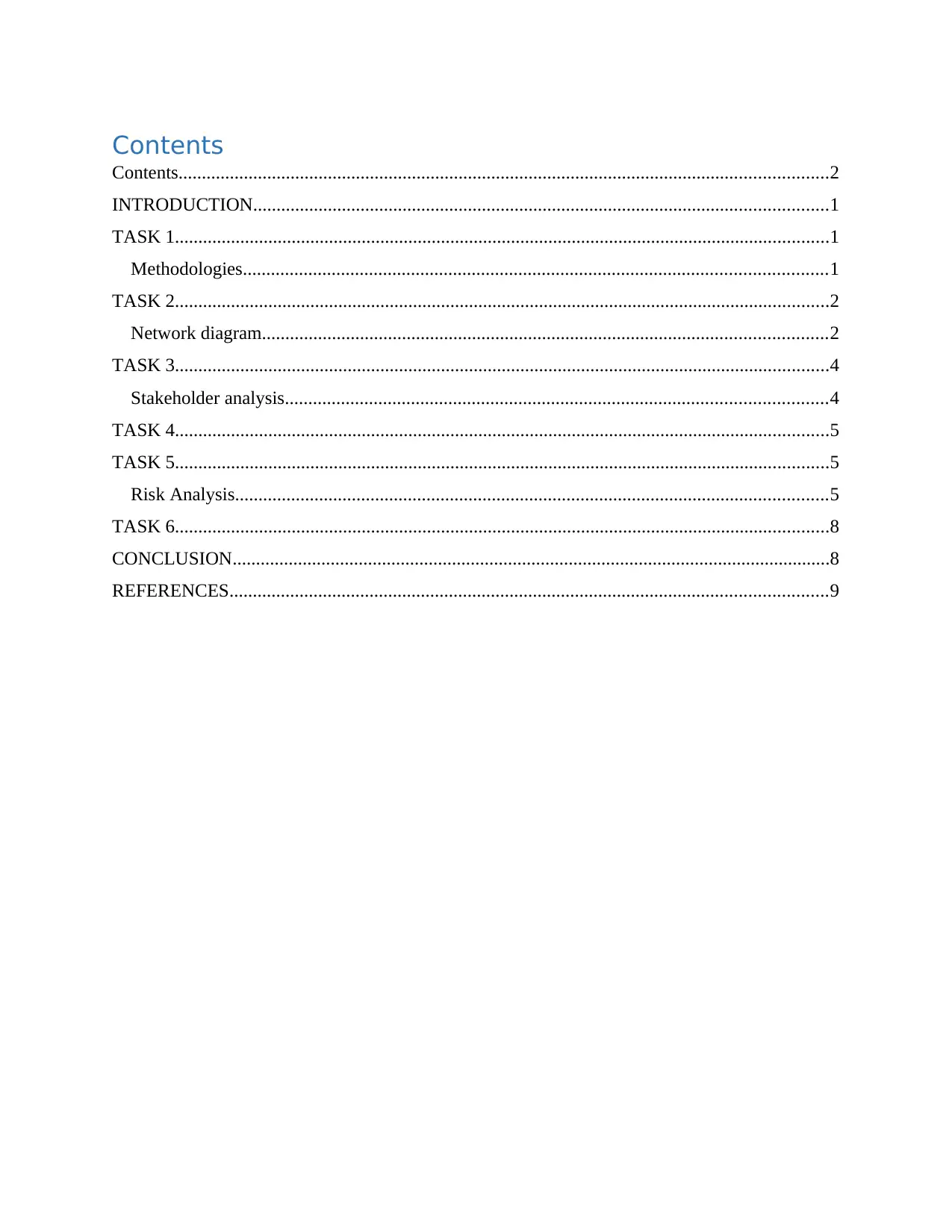
Contents
Contents...........................................................................................................................................2
INTRODUCTION...........................................................................................................................1
TASK 1............................................................................................................................................1
Methodologies.............................................................................................................................1
TASK 2............................................................................................................................................2
Network diagram.........................................................................................................................2
TASK 3............................................................................................................................................4
Stakeholder analysis....................................................................................................................4
TASK 4............................................................................................................................................5
TASK 5............................................................................................................................................5
Risk Analysis...............................................................................................................................5
TASK 6............................................................................................................................................8
CONCLUSION................................................................................................................................8
REFERENCES................................................................................................................................9
Contents...........................................................................................................................................2
INTRODUCTION...........................................................................................................................1
TASK 1............................................................................................................................................1
Methodologies.............................................................................................................................1
TASK 2............................................................................................................................................2
Network diagram.........................................................................................................................2
TASK 3............................................................................................................................................4
Stakeholder analysis....................................................................................................................4
TASK 4............................................................................................................................................5
TASK 5............................................................................................................................................5
Risk Analysis...............................................................................................................................5
TASK 6............................................................................................................................................8
CONCLUSION................................................................................................................................8
REFERENCES................................................................................................................................9

⊘ This is a preview!⊘
Do you want full access?
Subscribe today to unlock all pages.

Trusted by 1+ million students worldwide
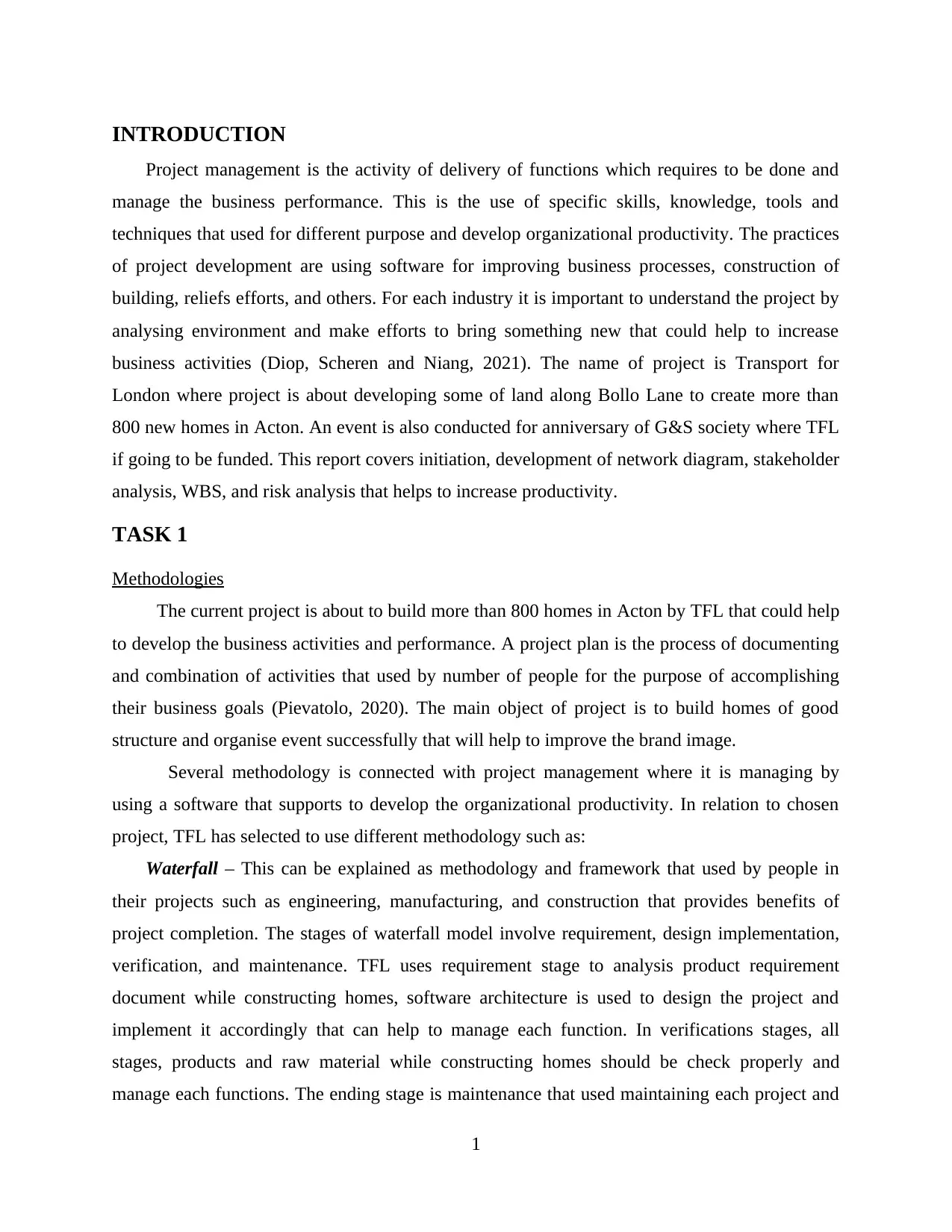
INTRODUCTION
Project management is the activity of delivery of functions which requires to be done and
manage the business performance. This is the use of specific skills, knowledge, tools and
techniques that used for different purpose and develop organizational productivity. The practices
of project development are using software for improving business processes, construction of
building, reliefs efforts, and others. For each industry it is important to understand the project by
analysing environment and make efforts to bring something new that could help to increase
business activities (Diop, Scheren and Niang, 2021). The name of project is Transport for
London where project is about developing some of land along Bollo Lane to create more than
800 new homes in Acton. An event is also conducted for anniversary of G&S society where TFL
if going to be funded. This report covers initiation, development of network diagram, stakeholder
analysis, WBS, and risk analysis that helps to increase productivity.
TASK 1
Methodologies
The current project is about to build more than 800 homes in Acton by TFL that could help
to develop the business activities and performance. A project plan is the process of documenting
and combination of activities that used by number of people for the purpose of accomplishing
their business goals (Pievatolo, 2020). The main object of project is to build homes of good
structure and organise event successfully that will help to improve the brand image.
Several methodology is connected with project management where it is managing by
using a software that supports to develop the organizational productivity. In relation to chosen
project, TFL has selected to use different methodology such as:
Waterfall – This can be explained as methodology and framework that used by people in
their projects such as engineering, manufacturing, and construction that provides benefits of
project completion. The stages of waterfall model involve requirement, design implementation,
verification, and maintenance. TFL uses requirement stage to analysis product requirement
document while constructing homes, software architecture is used to design the project and
implement it accordingly that can help to manage each function. In verifications stages, all
stages, products and raw material while constructing homes should be check properly and
manage each functions. The ending stage is maintenance that used maintaining each project and
1
Project management is the activity of delivery of functions which requires to be done and
manage the business performance. This is the use of specific skills, knowledge, tools and
techniques that used for different purpose and develop organizational productivity. The practices
of project development are using software for improving business processes, construction of
building, reliefs efforts, and others. For each industry it is important to understand the project by
analysing environment and make efforts to bring something new that could help to increase
business activities (Diop, Scheren and Niang, 2021). The name of project is Transport for
London where project is about developing some of land along Bollo Lane to create more than
800 new homes in Acton. An event is also conducted for anniversary of G&S society where TFL
if going to be funded. This report covers initiation, development of network diagram, stakeholder
analysis, WBS, and risk analysis that helps to increase productivity.
TASK 1
Methodologies
The current project is about to build more than 800 homes in Acton by TFL that could help
to develop the business activities and performance. A project plan is the process of documenting
and combination of activities that used by number of people for the purpose of accomplishing
their business goals (Pievatolo, 2020). The main object of project is to build homes of good
structure and organise event successfully that will help to improve the brand image.
Several methodology is connected with project management where it is managing by
using a software that supports to develop the organizational productivity. In relation to chosen
project, TFL has selected to use different methodology such as:
Waterfall – This can be explained as methodology and framework that used by people in
their projects such as engineering, manufacturing, and construction that provides benefits of
project completion. The stages of waterfall model involve requirement, design implementation,
verification, and maintenance. TFL uses requirement stage to analysis product requirement
document while constructing homes, software architecture is used to design the project and
implement it accordingly that can help to manage each function. In verifications stages, all
stages, products and raw material while constructing homes should be check properly and
manage each functions. The ending stage is maintenance that used maintaining each project and
1
Paraphrase This Document
Need a fresh take? Get an instant paraphrase of this document with our AI Paraphraser
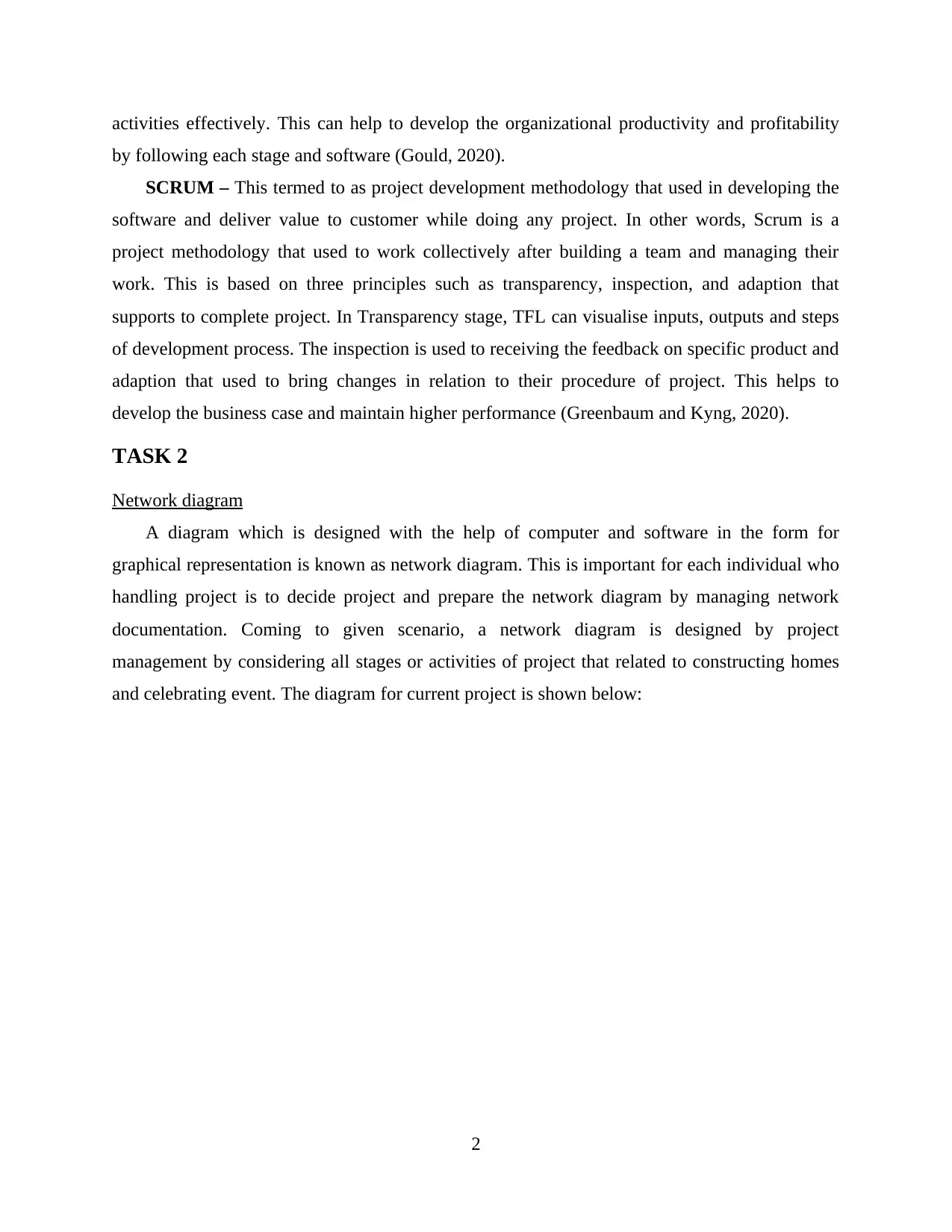
activities effectively. This can help to develop the organizational productivity and profitability
by following each stage and software (Gould, 2020).
SCRUM – This termed to as project development methodology that used in developing the
software and deliver value to customer while doing any project. In other words, Scrum is a
project methodology that used to work collectively after building a team and managing their
work. This is based on three principles such as transparency, inspection, and adaption that
supports to complete project. In Transparency stage, TFL can visualise inputs, outputs and steps
of development process. The inspection is used to receiving the feedback on specific product and
adaption that used to bring changes in relation to their procedure of project. This helps to
develop the business case and maintain higher performance (Greenbaum and Kyng, 2020).
TASK 2
Network diagram
A diagram which is designed with the help of computer and software in the form for
graphical representation is known as network diagram. This is important for each individual who
handling project is to decide project and prepare the network diagram by managing network
documentation. Coming to given scenario, a network diagram is designed by project
management by considering all stages or activities of project that related to constructing homes
and celebrating event. The diagram for current project is shown below:
2
by following each stage and software (Gould, 2020).
SCRUM – This termed to as project development methodology that used in developing the
software and deliver value to customer while doing any project. In other words, Scrum is a
project methodology that used to work collectively after building a team and managing their
work. This is based on three principles such as transparency, inspection, and adaption that
supports to complete project. In Transparency stage, TFL can visualise inputs, outputs and steps
of development process. The inspection is used to receiving the feedback on specific product and
adaption that used to bring changes in relation to their procedure of project. This helps to
develop the business case and maintain higher performance (Greenbaum and Kyng, 2020).
TASK 2
Network diagram
A diagram which is designed with the help of computer and software in the form for
graphical representation is known as network diagram. This is important for each individual who
handling project is to decide project and prepare the network diagram by managing network
documentation. Coming to given scenario, a network diagram is designed by project
management by considering all stages or activities of project that related to constructing homes
and celebrating event. The diagram for current project is shown below:
2
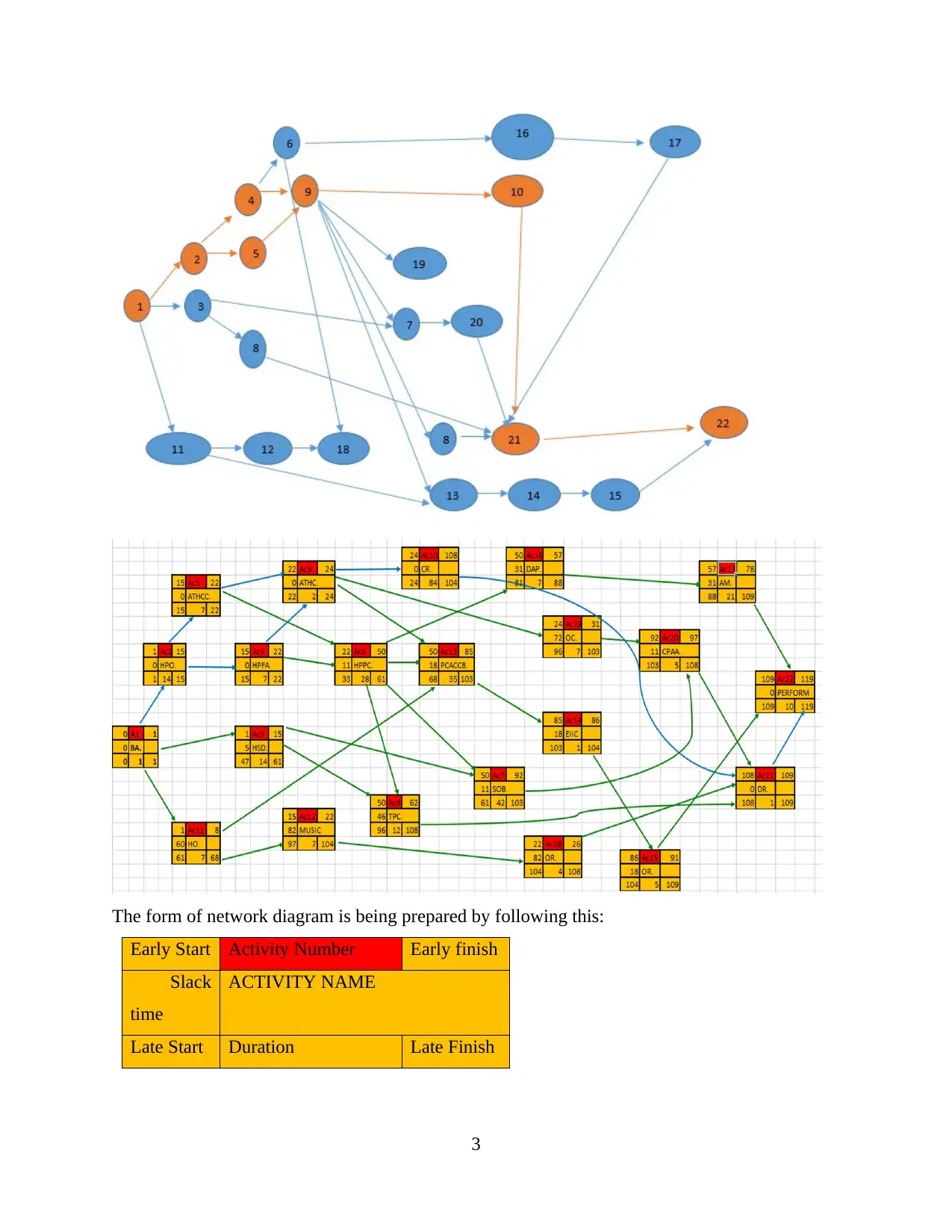
The form of network diagram is being prepared by following this:
Early Start Activity Number Early finish
Slack
time
ACTIVITY NAME
Late Start Duration Late Finish
3
Early Start Activity Number Early finish
Slack
time
ACTIVITY NAME
Late Start Duration Late Finish
3
⊘ This is a preview!⊘
Do you want full access?
Subscribe today to unlock all pages.

Trusted by 1+ million students worldwide
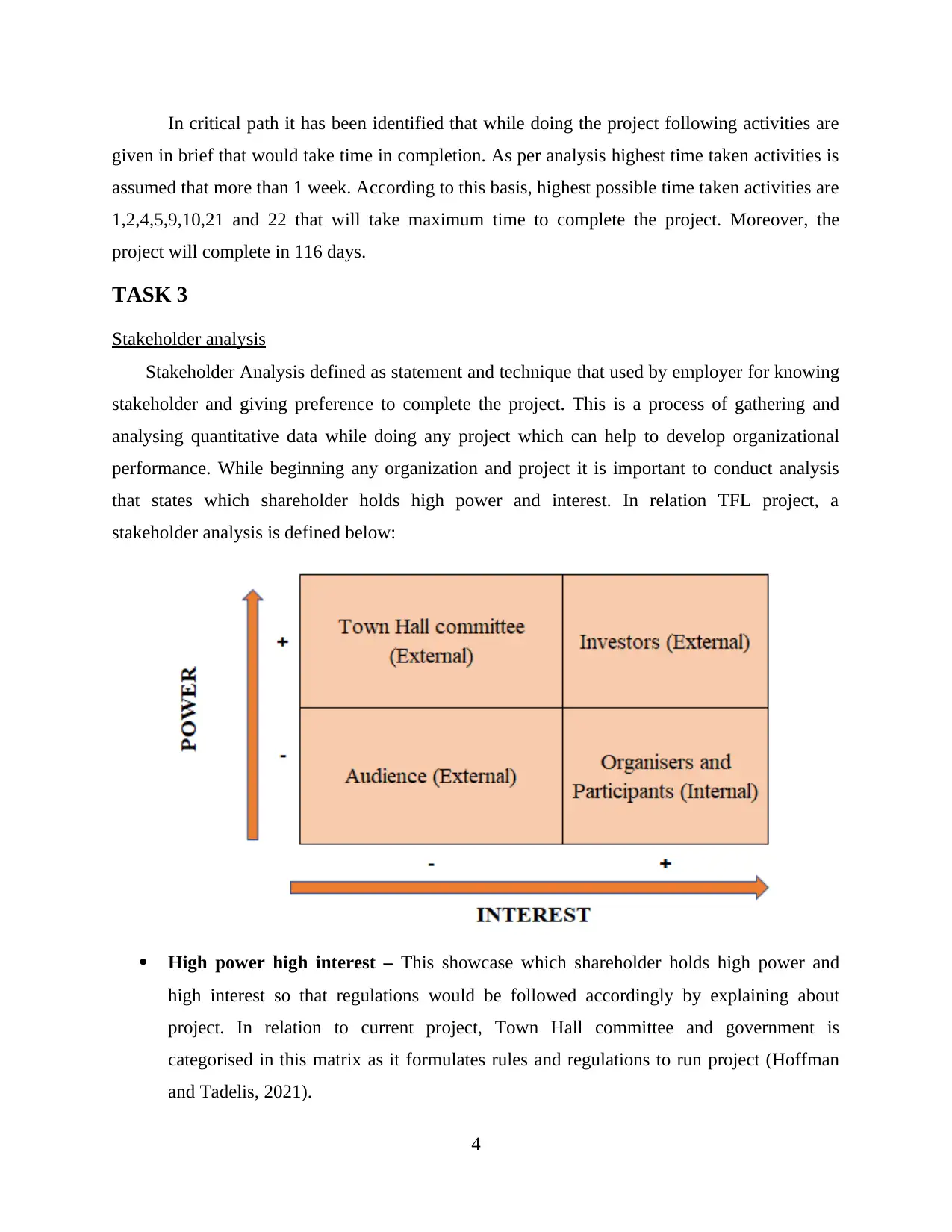
In critical path it has been identified that while doing the project following activities are
given in brief that would take time in completion. As per analysis highest time taken activities is
assumed that more than 1 week. According to this basis, highest possible time taken activities are
1,2,4,5,9,10,21 and 22 that will take maximum time to complete the project. Moreover, the
project will complete in 116 days.
TASK 3
Stakeholder analysis
Stakeholder Analysis defined as statement and technique that used by employer for knowing
stakeholder and giving preference to complete the project. This is a process of gathering and
analysing quantitative data while doing any project which can help to develop organizational
performance. While beginning any organization and project it is important to conduct analysis
that states which shareholder holds high power and interest. In relation TFL project, a
stakeholder analysis is defined below:
High power high interest – This showcase which shareholder holds high power and
high interest so that regulations would be followed accordingly by explaining about
project. In relation to current project, Town Hall committee and government is
categorised in this matrix as it formulates rules and regulations to run project (Hoffman
and Tadelis, 2021).
4
given in brief that would take time in completion. As per analysis highest time taken activities is
assumed that more than 1 week. According to this basis, highest possible time taken activities are
1,2,4,5,9,10,21 and 22 that will take maximum time to complete the project. Moreover, the
project will complete in 116 days.
TASK 3
Stakeholder analysis
Stakeholder Analysis defined as statement and technique that used by employer for knowing
stakeholder and giving preference to complete the project. This is a process of gathering and
analysing quantitative data while doing any project which can help to develop organizational
performance. While beginning any organization and project it is important to conduct analysis
that states which shareholder holds high power and interest. In relation TFL project, a
stakeholder analysis is defined below:
High power high interest – This showcase which shareholder holds high power and
high interest so that regulations would be followed accordingly by explaining about
project. In relation to current project, Town Hall committee and government is
categorised in this matrix as it formulates rules and regulations to run project (Hoffman
and Tadelis, 2021).
4
Paraphrase This Document
Need a fresh take? Get an instant paraphrase of this document with our AI Paraphraser
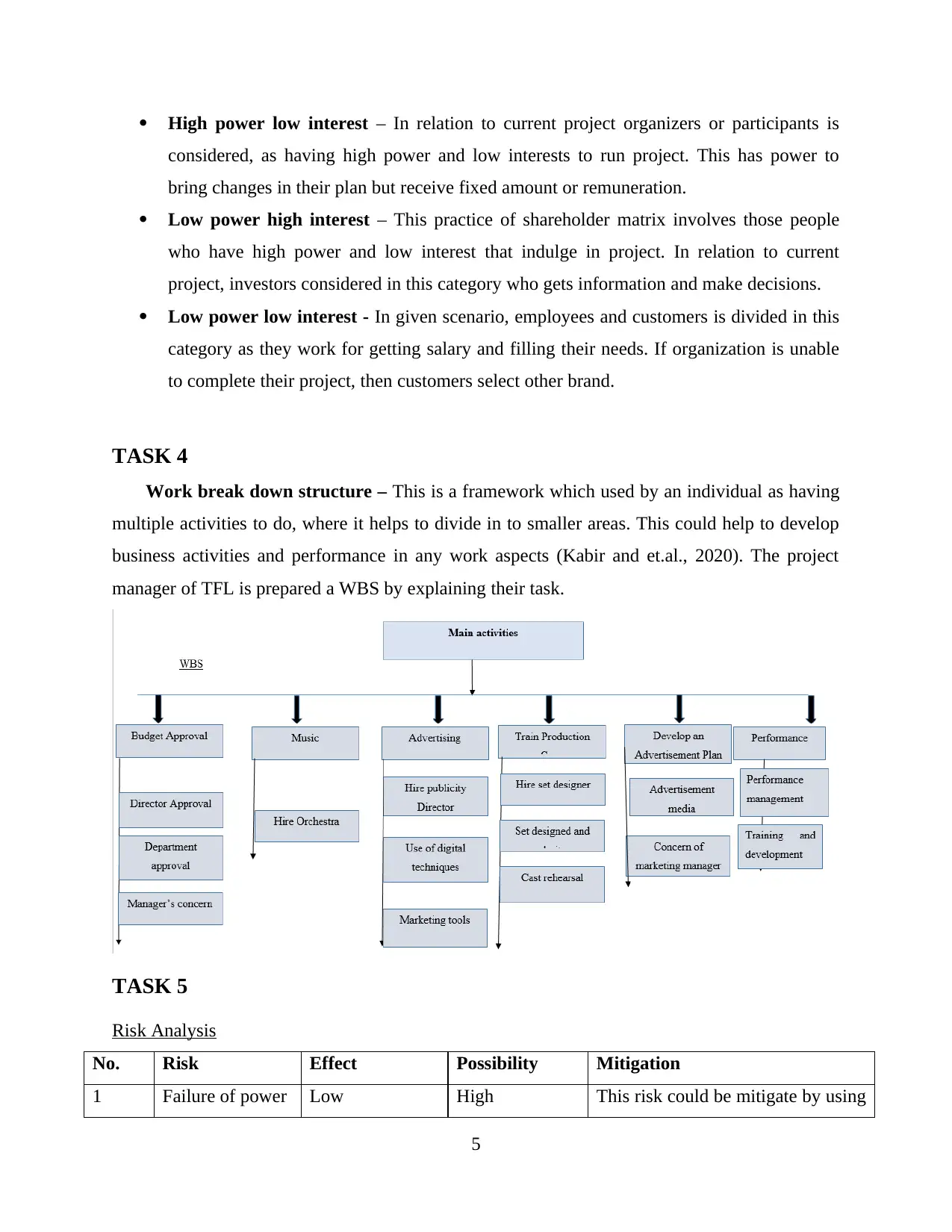
High power low interest – In relation to current project organizers or participants is
considered, as having high power and low interests to run project. This has power to
bring changes in their plan but receive fixed amount or remuneration.
Low power high interest – This practice of shareholder matrix involves those people
who have high power and low interest that indulge in project. In relation to current
project, investors considered in this category who gets information and make decisions.
Low power low interest - In given scenario, employees and customers is divided in this
category as they work for getting salary and filling their needs. If organization is unable
to complete their project, then customers select other brand.
TASK 4
Work break down structure – This is a framework which used by an individual as having
multiple activities to do, where it helps to divide in to smaller areas. This could help to develop
business activities and performance in any work aspects (Kabir and et.al., 2020). The project
manager of TFL is prepared a WBS by explaining their task.
TASK 5
Risk Analysis
No. Risk Effect Possibility Mitigation
1 Failure of power Low High This risk could be mitigate by using
5
considered, as having high power and low interests to run project. This has power to
bring changes in their plan but receive fixed amount or remuneration.
Low power high interest – This practice of shareholder matrix involves those people
who have high power and low interest that indulge in project. In relation to current
project, investors considered in this category who gets information and make decisions.
Low power low interest - In given scenario, employees and customers is divided in this
category as they work for getting salary and filling their needs. If organization is unable
to complete their project, then customers select other brand.
TASK 4
Work break down structure – This is a framework which used by an individual as having
multiple activities to do, where it helps to divide in to smaller areas. This could help to develop
business activities and performance in any work aspects (Kabir and et.al., 2020). The project
manager of TFL is prepared a WBS by explaining their task.
TASK 5
Risk Analysis
No. Risk Effect Possibility Mitigation
1 Failure of power Low High This risk could be mitigate by using
5
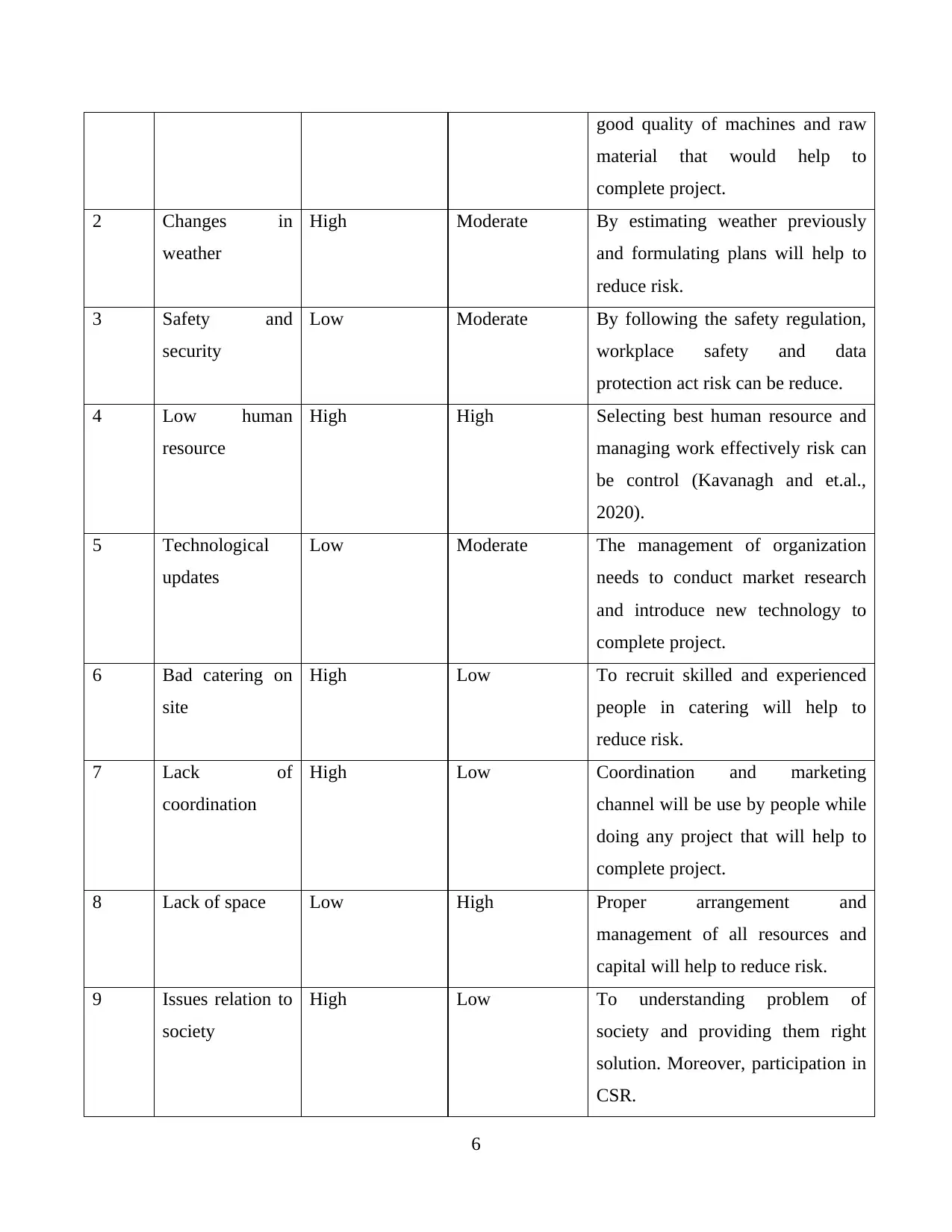
good quality of machines and raw
material that would help to
complete project.
2 Changes in
weather
High Moderate By estimating weather previously
and formulating plans will help to
reduce risk.
3 Safety and
security
Low Moderate By following the safety regulation,
workplace safety and data
protection act risk can be reduce.
4 Low human
resource
High High Selecting best human resource and
managing work effectively risk can
be control (Kavanagh and et.al.,
2020).
5 Technological
updates
Low Moderate The management of organization
needs to conduct market research
and introduce new technology to
complete project.
6 Bad catering on
site
High Low To recruit skilled and experienced
people in catering will help to
reduce risk.
7 Lack of
coordination
High Low Coordination and marketing
channel will be use by people while
doing any project that will help to
complete project.
8 Lack of space Low High Proper arrangement and
management of all resources and
capital will help to reduce risk.
9 Issues relation to
society
High Low To understanding problem of
society and providing them right
solution. Moreover, participation in
CSR.
6
material that would help to
complete project.
2 Changes in
weather
High Moderate By estimating weather previously
and formulating plans will help to
reduce risk.
3 Safety and
security
Low Moderate By following the safety regulation,
workplace safety and data
protection act risk can be reduce.
4 Low human
resource
High High Selecting best human resource and
managing work effectively risk can
be control (Kavanagh and et.al.,
2020).
5 Technological
updates
Low Moderate The management of organization
needs to conduct market research
and introduce new technology to
complete project.
6 Bad catering on
site
High Low To recruit skilled and experienced
people in catering will help to
reduce risk.
7 Lack of
coordination
High Low Coordination and marketing
channel will be use by people while
doing any project that will help to
complete project.
8 Lack of space Low High Proper arrangement and
management of all resources and
capital will help to reduce risk.
9 Issues relation to
society
High Low To understanding problem of
society and providing them right
solution. Moreover, participation in
CSR.
6
⊘ This is a preview!⊘
Do you want full access?
Subscribe today to unlock all pages.

Trusted by 1+ million students worldwide
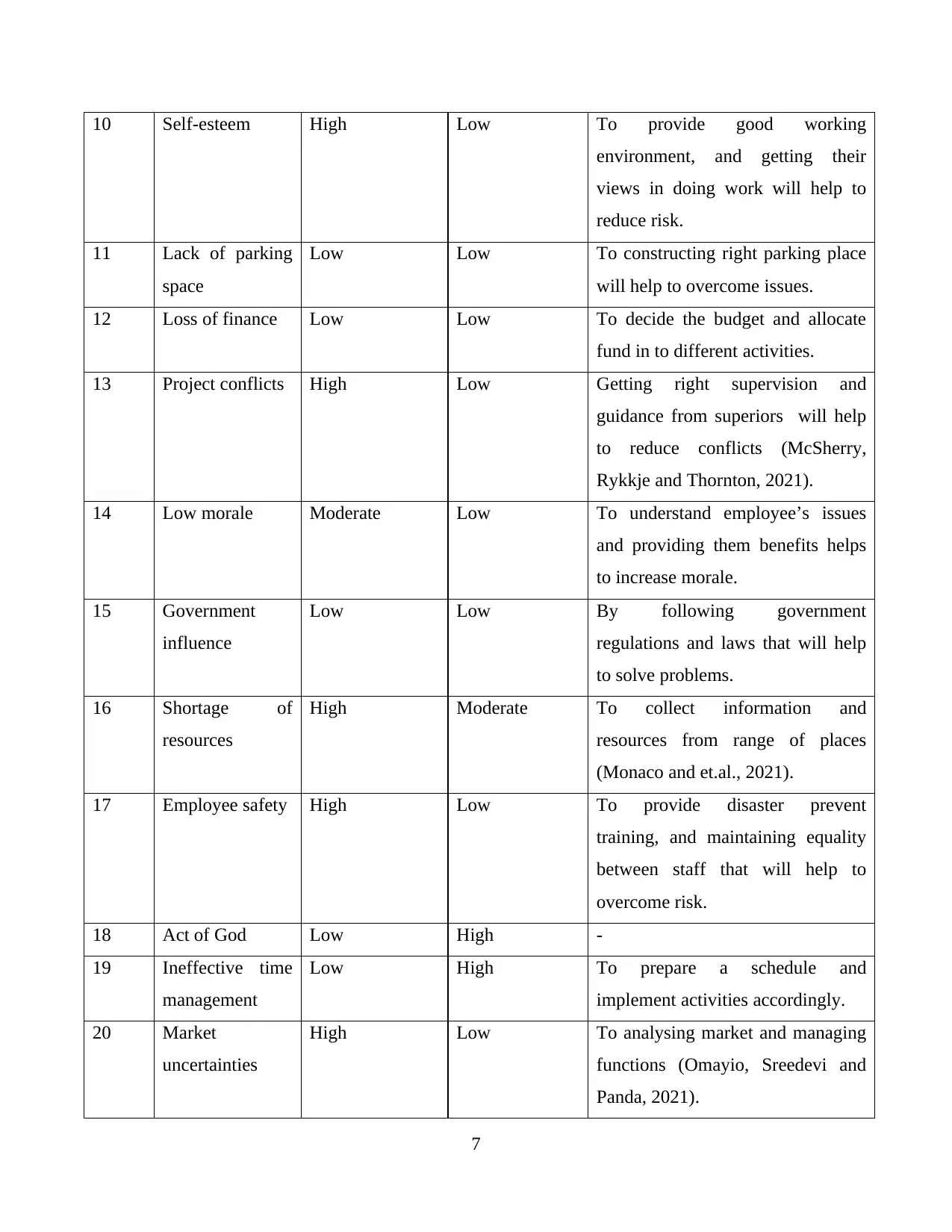
10 Self-esteem High Low To provide good working
environment, and getting their
views in doing work will help to
reduce risk.
11 Lack of parking
space
Low Low To constructing right parking place
will help to overcome issues.
12 Loss of finance Low Low To decide the budget and allocate
fund in to different activities.
13 Project conflicts High Low Getting right supervision and
guidance from superiors will help
to reduce conflicts (McSherry,
Rykkje and Thornton, 2021).
14 Low morale Moderate Low To understand employee’s issues
and providing them benefits helps
to increase morale.
15 Government
influence
Low Low By following government
regulations and laws that will help
to solve problems.
16 Shortage of
resources
High Moderate To collect information and
resources from range of places
(Monaco and et.al., 2021).
17 Employee safety High Low To provide disaster prevent
training, and maintaining equality
between staff that will help to
overcome risk.
18 Act of God Low High -
19 Ineffective time
management
Low High To prepare a schedule and
implement activities accordingly.
20 Market
uncertainties
High Low To analysing market and managing
functions (Omayio, Sreedevi and
Panda, 2021).
7
environment, and getting their
views in doing work will help to
reduce risk.
11 Lack of parking
space
Low Low To constructing right parking place
will help to overcome issues.
12 Loss of finance Low Low To decide the budget and allocate
fund in to different activities.
13 Project conflicts High Low Getting right supervision and
guidance from superiors will help
to reduce conflicts (McSherry,
Rykkje and Thornton, 2021).
14 Low morale Moderate Low To understand employee’s issues
and providing them benefits helps
to increase morale.
15 Government
influence
Low Low By following government
regulations and laws that will help
to solve problems.
16 Shortage of
resources
High Moderate To collect information and
resources from range of places
(Monaco and et.al., 2021).
17 Employee safety High Low To provide disaster prevent
training, and maintaining equality
between staff that will help to
overcome risk.
18 Act of God Low High -
19 Ineffective time
management
Low High To prepare a schedule and
implement activities accordingly.
20 Market
uncertainties
High Low To analysing market and managing
functions (Omayio, Sreedevi and
Panda, 2021).
7
Paraphrase This Document
Need a fresh take? Get an instant paraphrase of this document with our AI Paraphraser
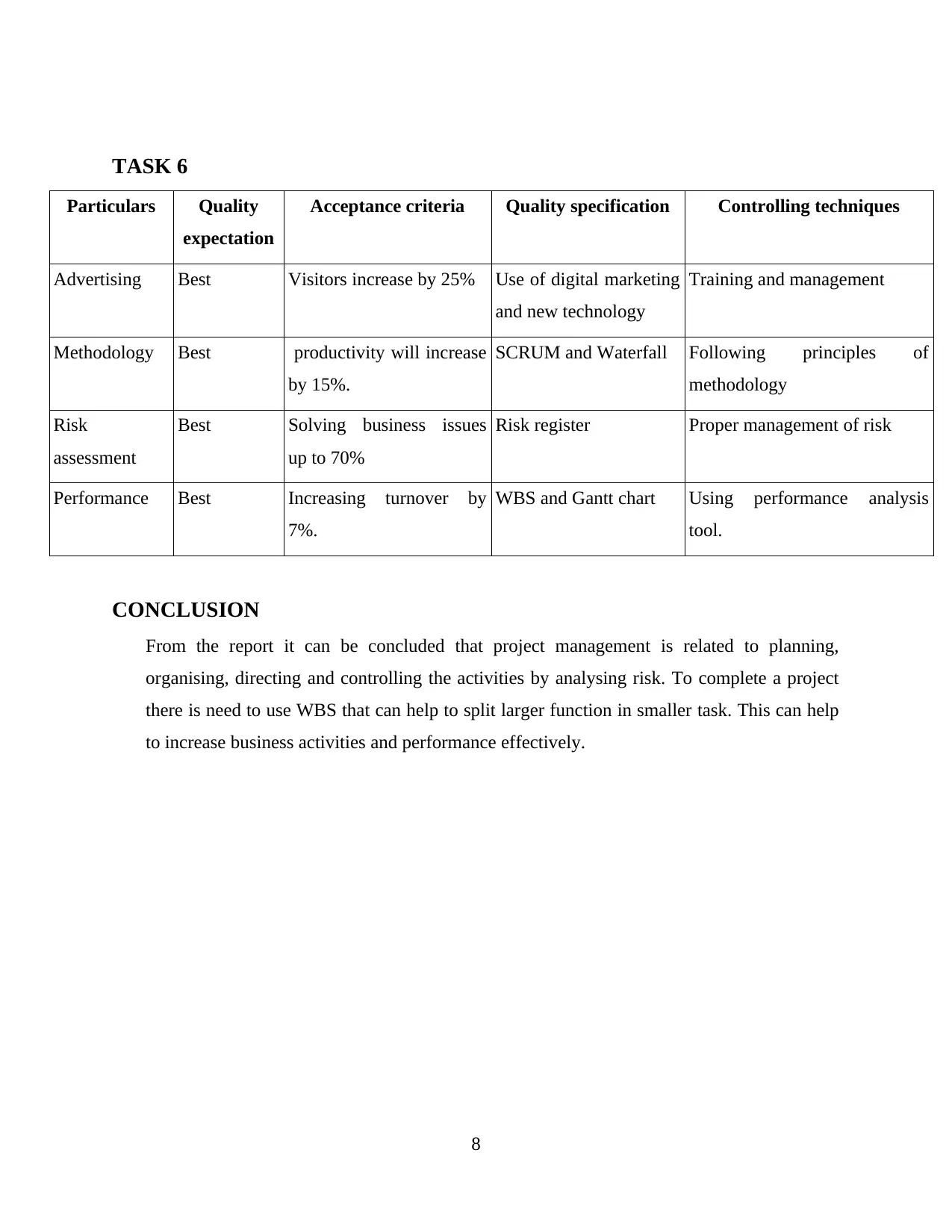
TASK 6
Particulars Quality
expectation
Acceptance criteria Quality specification Controlling techniques
Advertising Best Visitors increase by 25% Use of digital marketing
and new technology
Training and management
Methodology Best productivity will increase
by 15%.
SCRUM and Waterfall Following principles of
methodology
Risk
assessment
Best Solving business issues
up to 70%
Risk register Proper management of risk
Performance Best Increasing turnover by
7%.
WBS and Gantt chart Using performance analysis
tool.
CONCLUSION
From the report it can be concluded that project management is related to planning,
organising, directing and controlling the activities by analysing risk. To complete a project
there is need to use WBS that can help to split larger function in smaller task. This can help
to increase business activities and performance effectively.
8
Particulars Quality
expectation
Acceptance criteria Quality specification Controlling techniques
Advertising Best Visitors increase by 25% Use of digital marketing
and new technology
Training and management
Methodology Best productivity will increase
by 15%.
SCRUM and Waterfall Following principles of
methodology
Risk
assessment
Best Solving business issues
up to 70%
Risk register Proper management of risk
Performance Best Increasing turnover by
7%.
WBS and Gantt chart Using performance analysis
tool.
CONCLUSION
From the report it can be concluded that project management is related to planning,
organising, directing and controlling the activities by analysing risk. To complete a project
there is need to use WBS that can help to split larger function in smaller task. This can help
to increase business activities and performance effectively.
8
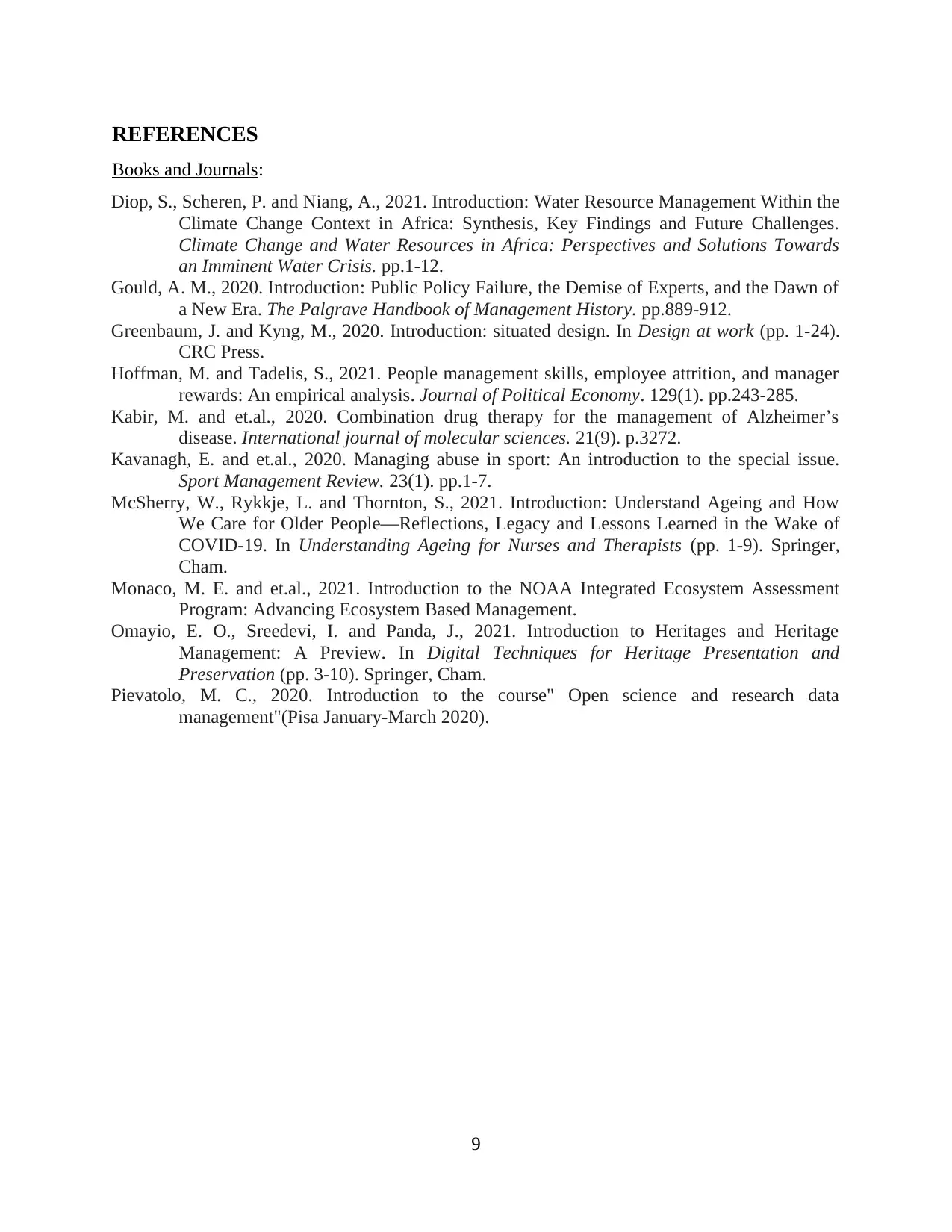
REFERENCES
Books and Journals:
Diop, S., Scheren, P. and Niang, A., 2021. Introduction: Water Resource Management Within the
Climate Change Context in Africa: Synthesis, Key Findings and Future Challenges.
Climate Change and Water Resources in Africa: Perspectives and Solutions Towards
an Imminent Water Crisis. pp.1-12.
Gould, A. M., 2020. Introduction: Public Policy Failure, the Demise of Experts, and the Dawn of
a New Era. The Palgrave Handbook of Management History. pp.889-912.
Greenbaum, J. and Kyng, M., 2020. Introduction: situated design. In Design at work (pp. 1-24).
CRC Press.
Hoffman, M. and Tadelis, S., 2021. People management skills, employee attrition, and manager
rewards: An empirical analysis. Journal of Political Economy. 129(1). pp.243-285.
Kabir, M. and et.al., 2020. Combination drug therapy for the management of Alzheimer’s
disease. International journal of molecular sciences. 21(9). p.3272.
Kavanagh, E. and et.al., 2020. Managing abuse in sport: An introduction to the special issue.
Sport Management Review. 23(1). pp.1-7.
McSherry, W., Rykkje, L. and Thornton, S., 2021. Introduction: Understand Ageing and How
We Care for Older People—Reflections, Legacy and Lessons Learned in the Wake of
COVID-19. In Understanding Ageing for Nurses and Therapists (pp. 1-9). Springer,
Cham.
Monaco, M. E. and et.al., 2021. Introduction to the NOAA Integrated Ecosystem Assessment
Program: Advancing Ecosystem Based Management.
Omayio, E. O., Sreedevi, I. and Panda, J., 2021. Introduction to Heritages and Heritage
Management: A Preview. In Digital Techniques for Heritage Presentation and
Preservation (pp. 3-10). Springer, Cham.
Pievatolo, M. C., 2020. Introduction to the course" Open science and research data
management"(Pisa January-March 2020).
9
Books and Journals:
Diop, S., Scheren, P. and Niang, A., 2021. Introduction: Water Resource Management Within the
Climate Change Context in Africa: Synthesis, Key Findings and Future Challenges.
Climate Change and Water Resources in Africa: Perspectives and Solutions Towards
an Imminent Water Crisis. pp.1-12.
Gould, A. M., 2020. Introduction: Public Policy Failure, the Demise of Experts, and the Dawn of
a New Era. The Palgrave Handbook of Management History. pp.889-912.
Greenbaum, J. and Kyng, M., 2020. Introduction: situated design. In Design at work (pp. 1-24).
CRC Press.
Hoffman, M. and Tadelis, S., 2021. People management skills, employee attrition, and manager
rewards: An empirical analysis. Journal of Political Economy. 129(1). pp.243-285.
Kabir, M. and et.al., 2020. Combination drug therapy for the management of Alzheimer’s
disease. International journal of molecular sciences. 21(9). p.3272.
Kavanagh, E. and et.al., 2020. Managing abuse in sport: An introduction to the special issue.
Sport Management Review. 23(1). pp.1-7.
McSherry, W., Rykkje, L. and Thornton, S., 2021. Introduction: Understand Ageing and How
We Care for Older People—Reflections, Legacy and Lessons Learned in the Wake of
COVID-19. In Understanding Ageing for Nurses and Therapists (pp. 1-9). Springer,
Cham.
Monaco, M. E. and et.al., 2021. Introduction to the NOAA Integrated Ecosystem Assessment
Program: Advancing Ecosystem Based Management.
Omayio, E. O., Sreedevi, I. and Panda, J., 2021. Introduction to Heritages and Heritage
Management: A Preview. In Digital Techniques for Heritage Presentation and
Preservation (pp. 3-10). Springer, Cham.
Pievatolo, M. C., 2020. Introduction to the course" Open science and research data
management"(Pisa January-March 2020).
9
⊘ This is a preview!⊘
Do you want full access?
Subscribe today to unlock all pages.

Trusted by 1+ million students worldwide
1 out of 12
Related Documents
Your All-in-One AI-Powered Toolkit for Academic Success.
+13062052269
info@desklib.com
Available 24*7 on WhatsApp / Email
![[object Object]](/_next/static/media/star-bottom.7253800d.svg)
Unlock your academic potential
Copyright © 2020–2025 A2Z Services. All Rights Reserved. Developed and managed by ZUCOL.